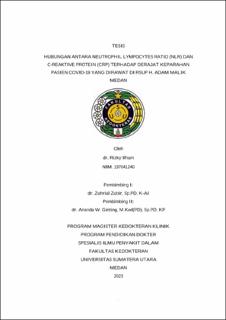| dc.description.abstract | Introduction
Coronavirus Disease 2019 (COVID-19) is an infectious disease caused by
Severe Acute Respiratory Syndrome Coronavirus 2 (SARSCoV2). Patients infected with COVID-19 experience an inflammatory response in the body which causes disruption of the immune response. In an inflammatory reaction, neutrophils and macrophages enter the injured tissue so that systemic inflammation suppresses cellular immunity. Neutrophils are very important in the inflammatory response, while lymphocytes have an important role in the immune response.
Neutrophils are polymorphonuclear phagocytes in the form of granules containing toxic substances that kill germs or prevent the life of bacteria and fungi by activating the respiratory tract and producing strong oxidizing agents including hydrogen peroxide, oxygen free radicals and hypochlorite. Neutrophils destroy
microbes through independent oxygen pathways (lysozyme, lactoferrin, ROI , proteolytic enzymes, cathepsin G and cationic proteins) and oxygen dependent.
Lymphocytes are a subclass of leukocytes that have round mononuclear nuclei with characteristic cytoplasmic granules. Among immune cells, T lymphocytes play a
major role in viral infections. CD4+ and T lymphocytes help B cells to produce antiviral
antibodies, while CD8+ T lymphocytes and natural killer cells (NK) kill virus-infected cells thereby reducing the viral load.
The Neutrophil-Lymphocytes Ratio (NLR) value in COVID-19 patients is widely
used by calculating the neutrophil value divided by the type of lymphocyte and is one of the inflammatory biomarkers of a systemic inflammatory response that can be used as a prognosis.
An increase in NLR reflects the progression of COVID-19 and is significantly
related to the severity of the disease. An increase in neutrophils indicates the intensity of the inflammatory response, while a decrease in the number of lymphocytes indicates damage to the immune system. Therefore, an increase in NLR can be a
prognostic parameter of the disease.
Method
The research was carried out at Haji Adam Malik General Hospital, Medan from January 1 2022 to December 1 2022. The research design was retrospective with an observational analytical approach and a cross-sectional design. Data collection from secondary data examination of medical records for NLR and CRP. The research sample consisted of patients undergoing treatment in the COVID-19 isolation ward at
H. Adam Malik Hospital Medan using the consecutive sampling method and who met the inclusion and exclusion criteria. Data analysis using SPSS ver. 26, with normality
test analysis using the Kolmogorov-Smirnov method. Data that is normally distributed will be analyzed using the independent sample t-test, while data that is not normally distributed will be analyzed using the Mann Whitney U test.
Results
Based on research, it is known that the relationship between NLR and CRP is
related to the severity of COVID-19. Statistically, based on the non-parametric Kruskalwallis test, it is known that NLR has a significant relationship with each degree of severity of COVID-19. Based on the ANOVA test, it is known that CRP also has a
significant relationship with each degree of severity of COVID-19.
The results of the analysis of the relationship between comorbid Diabetes
Mellitus and NLR and CRP levels, where statistically based on non-parametric tests, it was found that there was no significant relationship between Diabetes Mellitus and NLR and CRP values in COVID-19 patients (p>0.05). The results of the analysis of the
relationship between chronic kidney disease and NLR and CRP levels, where statistically based on non-parametric tests, it was found that there was no significant relationship between chronic kidney disease and NLR and CRP values in COVID-19
patients (p>0.05).
Based on the Mann Whitney U test, it can be seen that statistically there is a
significant relationship between NLR values and CRP levels on COVID-19 vaccination status.
Discussion
This research was conducted on moderate, severe and critical COVID-19
patients who were hospitalized at RSUP. H. Adam Malik Medan based on medical record data obtained in 2022. Data on the characteristics of research subjects in table 4.1 is presented based on Gaussian (Mean ± SD) and Non Gaussian (Mean, min-max)
data, it was found that there were no significant differences from the average age and gender for each degree of severity of COVID-19, but there is a significant relationship with comorbid Diabetes Mellitus, Chronic Kidney Disease and Vaccination Status.
Ergenc et al's (2021) research on the relationship between NLR and CRP on mortality found that age and gender had no effect in predicting COVID 19 mortality rates.
Statistically, based on the non-parametric Kruskal-wallis test, it is known that NLR has a significant relationship with each degree of severity of COVID-19. Based
on the ANOVA test, it is known that CRP also has a significant relationship with each m | en_US |


